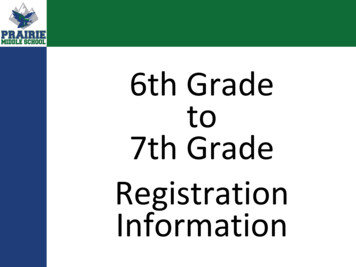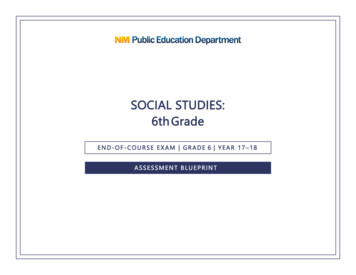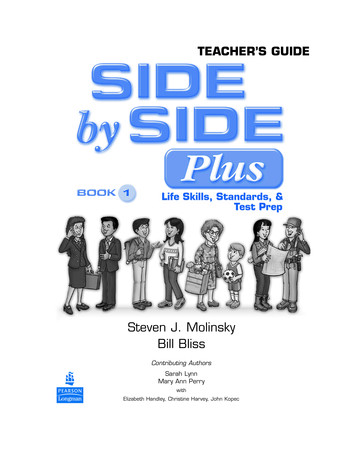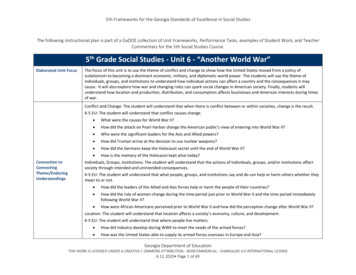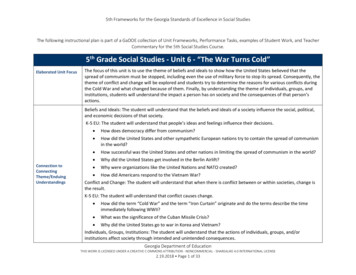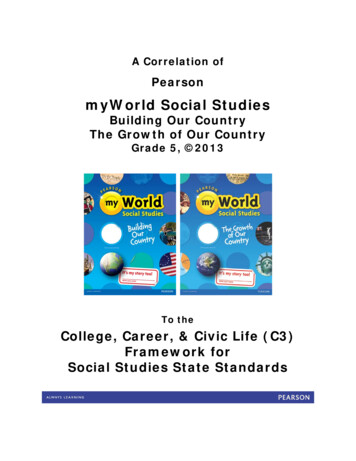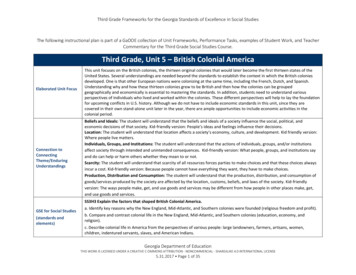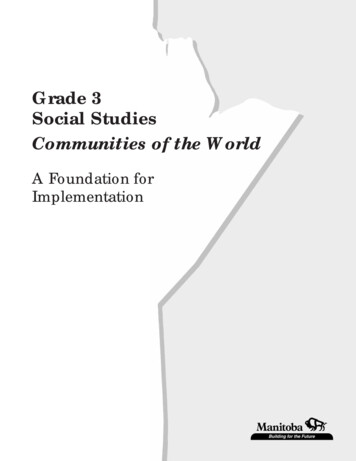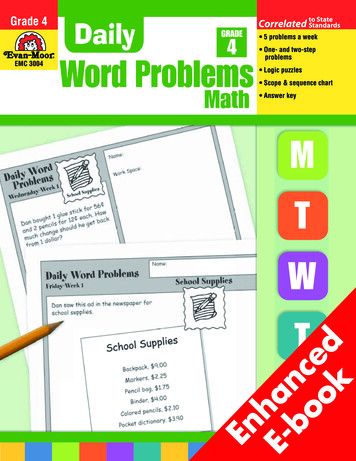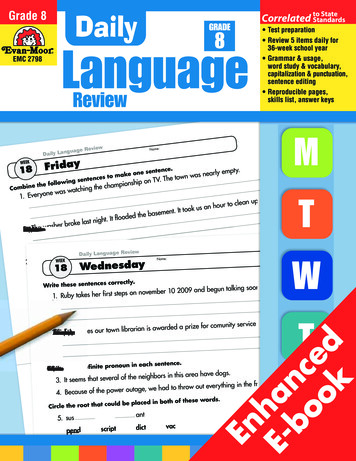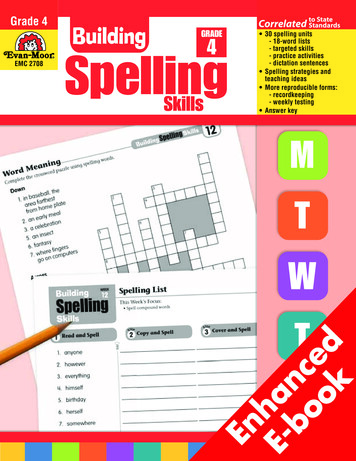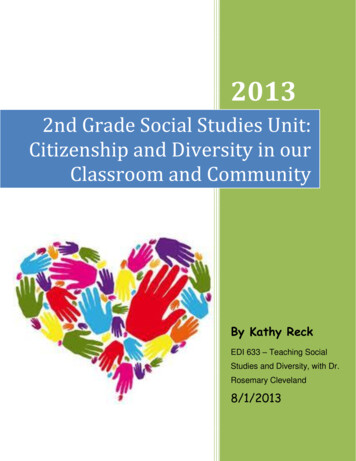
Transcription
20132nd Grade Social Studies Unit:Citizenship and Diversity in ourClassroom and CommunityBy Kathy ReckEDI 633 – Teaching SocialStudies and Diversity, with Dr.Rosemary Cleveland8/1/2013
2nd Grade Social Studies Unit PlanBy Kathy ReckUnit Title: Responsible Citizenship and Embracing Diversity in our Classroom andCommunityOverview: This unit explores diversity and the attributes of responsible citizenswithin the classroom and community.Main Ideas:Lesson 1: Are You a Good Citizen?Students learn to identify attributes of good citizenship and ways in which theycan contribute to the community. Students will view a picture of children in acommunity and identify ways that they are being good citizens. Students willidentify ways they themselves are currently good citizens and think of additionalthings they want to do to be good citizens.Lesson 2: Personal and Civic ResponsibilityStudents learn the difference between personal and civic responsibility. They alsolearn how both personal and civic responsibility impact community life. Studentswill write a song about personal and civic responsibility.Lesson 3: For the Common GoodStudents learn that individual rights must be balanced with the common good inorder for the best interests of citizens in a community to be served. Students willmake a classroom constitution.Lesson 4: Can You be a Bucket Filler?Students learn that their words and actions influence the way they feel and theway others feel. Students will identify nice words and actions that help “fill theirbucket” and the buckets of others, that are also qualities of good citizens.Lesson 5: Abraham Lincoln’s Impact on HistoryStudents recognize ways in which Abraham Lincoln, as an individual, had a profoundimpact on creating history. In this lesson, students begin learning note taking skillsand they take a virtual field trip to Americas Library to gather additionalinformation about Lincoln.
Lesson 6: Diversity with CrayonsStudents identify similarities and differences among each other. They learn thattheir unique qualities help make the classroom and community a better place. Theycreate a classroom crayon box, which will decorate the wall in the classroom, tohelp illustrate and remind students that our uniqueness helps make our classroombetter.Lesson 7: Caring for the CommunityThis lesson occurs over a couple of weeks. Students learn to recognize how, when,and who to help in the community. They will identify community and school needs,then plan and implement a community service project. After recording dailyjournal entries, students will write books about their service experience anddisplay these books for parents at a party celebrating a successful project.At the beginning of the unit, send home the attached newsletter with students.This helps inform parents, keep them involved and knowledgeable, and reinforcesthe material we will be learning by creating a platform for family discussions athome.Key concepts and terms: citizen, citizenship, constitution, personal responsibility,civic responsibility, culture, diversity, legislature, slavery, and community service.Related skills used or learned: group work, reading, writing, study and inquiry,higher-order thinking, art, music, movement, computerTypes of resources used: textbook, picture books, visual aids, vocabularydiagrams, internet, and computer.Summative assessments will be done via journal writing, song writing, art work,collage, choral response, and classroom discussion.Formative assessment will be books written by students about citizenship andcommunity service.Parent helpers needed in computer lab for Lessons 5 and 7.
Unit: Responsible Citizenship in our Classroom and CommunityGrade: 2Subject Area: Social Studies – Civics and GovernmentLesson 1: Are You a Good Citizen?I.Standard:What is the district’s curriculum/grade-level guideline(s).2-C5.0.1 Identify ways citizens participate in community decisions.II.Objective/Benchmark:What am I going to teach? What will the students be able to do at the end of the lesson?How will it be measured/observed?A. The student will learn to identify ways that citizens participate incommunity decisions.B. Students: I can identify ways in which citizens help make communitydecisions.C. Students: I can identify the importance of my contributions to mycommunity/classroom.III.Anticipatory Set:How will I get the students motivated, interested, and/or focused?What prior knowledge is necessary? What practice will be implemented?A. Show picture on overhead: Visual 13A What Does a Good Citizen Do? Ask students what they see.B. Tell students that we will be learning about how citizens make decisionsthat make the community a better place.IV.Input:A. Task Analysis: (what information do the students need?)1. Prior knowledge:a. Community - a place where people live, learn, work, play, and solveproblems together.2. Scaffolding:a. Discuss community.b. Discuss the picture of people in the community (citizens).c. Introduce the term citizen.
d. Discuss how citizens make a difference in their community.e. Discuss ways in which citizens help make community decisions.B. Thinking Levels: (write specific questions)1. Rememberinga. Who can tell me what a community is? (a place where people live,learn, work, play, and solve problems together)2. Understandinga. True/False questions/definitions on board or overheadfirst discuss with shoulder partner, then as a class. Do notdisclose answers yet. Students will “research” answers as we arereading the text.Citizen -a. An official member of a community (T)b. Only grown-ups (F)c. Can help make community decisions (T)d. Is an elected official (F)b. Tell students they will be acting as researchers to discover if theanswers are actually true or false.c. Ask if anyone can think of questions they want to find the answersto about what a citizen is.d. After each section, ask students if they have “found” any answersto the true/false questions.e. Read textbook together as a class, p. 139 – 143, one section at atime, pausing to discuss possible answers to questions.3. Applying – “Think, pair, share” for each question a. What are some things that you currently do as a good citizen in ourclassroom? Possible answers: help others, clean up, be kind, include othersb. What are some things that you currently do as a good citizen in ourcommunity? Possible answers: put trash in trash can, obey laws, solveproblems
4. Analyzing – In a small groups, take 3 minutes to discuss, then sharewith class a. What are some ways we can participate in community decisions? Possible answers: write letters to newspaper, write letters togovernment, go to important meetings with parents, encourageparents to vote, make signsb. Is there an issue in the school or community that you would like tohelp solve?5. Creating and Evaluating (optional)C. Method and Materials:1. Presentationa. Analyze pictureb. Present questionsc. Read text bookd. Find answers to questions in part be. Apply to selff. Apply to communityg. Formative Assessment – Journal Entry2. Engagement strategies Analyze picture Act as researchers Think, pair, share Group work Problem solvers3. Materials Picture “What does a Good Citizen Do?” Visual Aid 13A1 Social Studies Alive! Community student textbooks Social Studies Alive! Community “Good Citizens” CD1Social Studies Alive! Community. Visuals binder.
V.Modeling:Show as well as tell. How to do as well as what to do. VI.Teacher gives true/false questions to be researched. This models howstudents can begin thinking of their own questions to answer beforereading/researching text.Checking for Understanding:Write some sample questions. How will students respond?A. Show picture on overhead: Visual 13A What Does a Good Citizen Do?Ask students what they see.1. Why are people planting a tree? Possible answers: to help the environment, to make the townpretty2. Which people are helping others? Possible answers: a boy, a girl3. What are they doing to help? Possible answers: one boy is helping another one get up, a girl ishelping a lady with groceriesB. What are some ways we can participate in community decisions? Possible answers: write letters to newspaper, write letters togovernment, go to important meetings with parents, encourageparents to vote, make signsC. Is there an issue in the school or community that you would like to helpsolve? What would you like to do to solve the problem?Possible answers: trash on the ground – form groups for “pick-up” days weeds in the garden at school – form a volunteer committee people are hungry – start a food driveVII.ClosureHow will I wrap up the lesson for the students?Student journal entry which will be a formative assessment:1. Play “Good Citizens” song from Social Studies Alive! while students writethe following in their journals:a. Write or draw one way in which you are currently a good citizen inschool or the community.
b. Write or draw one way you plan on making the community or school abetter place sometime soon.VIII. Assessment/Reflection - n/a – done after teachingWhat is my overall reflection/evaluation of this completed lesson?Did I meet my teaching objective?How well did the students perform? What evidence provides this information?
Sources for Lesson 1:Second grade social studies grade level content expectations (n.d.). In Michigan.Retrieved July 2, 2013, SSGLCE 229666 7.pdfSocial studies alive! Community. Good Citizens Song. Palo Alto, CA: Teachers'Curriculum Institute, 2010. 47. Print.Social studies alive! Community. Student ed. Palo Alto, CA: Teachers' CurriculumInstitute, 2010. 139-43. Print.Social studies alive! Community. Visuals Binder. Palo Alto, CA: Teachers' CurriculumInstitute, 2010. 47. Print.
Unit: Responsible Citizenship in our Classroom and CommunityGrade: 2Subject Area: Social Studies – Civics and GovernmentLesson 2 – Personal and Civic ResponsibilityI.Standard:What is the district’s curriculum/grade-level guideline(s).2-C5.0.2 Distinguish between personal and civic responsibilities and explainwhy they are important in community life.II.Objective/Benchmark:What am I going to teach? What will the students be able to do at the end of the lesson?How will it be measured/observed?A. The student will be able to distinguish between personal and civicresponsibilities.B. The student will be able to explain why personal responsibilities areimportant in community life.C. The student will be able to explain why civic responsibilities areimportant in community life.III.Anticipatory Set:How will I get the students motivated, interested, and/or focused?What prior knowledge is necessary? What practice will be implemented?A. Watch Youtube video song: Together we can change the worldhttp://www.youtube.com/watch?v G0jDtkBpX-cB. Students will recognize that we all have the ability to make ourcommunity and classroom a better place.C. Ask students for specific ways they make the community and classroom abetter place. Possible answers: help someone who dropped their books, pick uptrash I find on the ground, visit a sick neighbor, play games withsomeone who is lonely, include people who are left out.
IV.Input:A. Task Analysis: (what information do the students need?)1. Prior knowledge:a. Community - : a place where people live, learn, work, play, and solveproblems together.b. Citizen – official member of a communityc. Tune of “Twinkle, Twinkle Little Star”2. Scaffolding:a. Discuss examples of responsibilities at homeb. Discuss examples of your responsibilities at school.c. Discuss examples of responsibilities in the community (by you oryour parents).d. Recognize the differences between responsibilities at home and inthe community.e. Discuss the idea of civic responsibility verses personalresponsibility.B. Thinking Levels: (write specific questions)1. Rememberinga. Turn and talk to a partner for 1 minute about some of yourresponsibilities at home. Then share as a class. Possible answers: feed the dog, brush teeth, set tableb. Turn and talk to a different partner for 1 minute about some ofyour responsibilities in our school. Then share as a class. Possible answers: Help younger students, include people whoare left out, do homework, follow the rules of the classroomand school.c. Turn and talk to another person for 1 minute about some of theresponsibilities in the community that you do. Possible answers: Pick up trash, obey the law (what kind of lawscan children obey? – use the cross walk, don’t steal, wearseatbelt), donate unused toys and clothes, recycle2. Understandinga. How are your responsibilities at home different than yourresponsibilities in the community? Possible answers: our responsibilities at home are for our owngood but our actions in the community affect others.
b. Write the terms “Personal Responsibility” and “Civic Responsibility”on the board. In small groups have students discuss:What do these two terms mean? How are they different? Howare they similar? Possible answers: Personal responsibilities are what we have todo for ourselves – decisions and actions that affect only us orour family. Civic responsibilities are things we do to obey thelaw and help others – decisions and actions that affect thepeople around us. They are similar because they areresponsibilities that we should remember to do without beingtold. They are different because one affects only us and theother affects other people around us.3. Applyinga. Working in small groups, use the “ABC Civics and Me” Sheet torecord as many examples you can think of personal and civicresponsibility. Write a “P” next to each personal responsibility anda “C” next to each civic responsibility.b. How many groups found 26 or more examples? 20? 15?c. Discuss the examples and teacher should make a master sheet ofall student responses.4. Analyzinga. Discuss the listed personal responsibilities and why they areimportant in community life. Students should recognize that when we clean up afterourselves, do our homework, and do our chores at home, itmakes the environment better for the people around us.b. Discuss the listed civil responsibilities and why they are importantin community life. Students should recognize that when we help others and obeythe rules, it makes our classroom, school, and community abetter place to live.c. What responsibilities might be both personal and civic? Possible answers: Throwing away our own trash in a public area,keeping your yard looking nice, obeying the lawd. Make and perform our own civics song (to the tune of . Each groupwill be responsible for one section of the song.5. Creating and Evaluating (optional)C. Method and Materials:
1. Presentationa. Watch civics song from YouTubeb. Discuss personal and civic responsibilitiesc. Complete ABC’s of Civic Responsibilityd. Write/create civics songe. Assessment: Song to tune of Twinkle, Twinkle Little Star2. Engagement strategiesa. Music/songb. Think, pair, sharec. Classroom discussionsd. ABC’s activitye. Create song3. Materials Computer access to video clip of civics song ABC’s of Civic Responsibility Sheet Video recording device for student performance of their own civicssong.V.Modeling:Show as well as tell. How to do as well as what to do.a. For ABC’s of Civics, give an example students can all write on their sheet: For the letter “X,” don’t eXclude others Other ideas for the ABC’s: ABC of good citizenship – list as many good or bad citizenship qualitiesas possible using the alphabet.A – ask permissionB – brush teethC - clean up toysD - do homeworkE – erase the boardF – feed the hungryG – get alongH – help othersI – include othersJ - jobK - knowledgeL - listen to others opinionsM - mannersN - nice
O - obey rulesP – plant plantsQ – quiet voicesR - respectS - shareT – don’t TeaseU – don’t Use someone’s things without askingV - visit sick friendsW - write letters to legislatureX – don’t eXclude othersY – don’t YellZ – zip it when others are talkingb. Create two line stanza for class song:“When we help each other outOur community is tops” c. Examples for rest of song “We can ”“I will ”“It is best ”VI.Checking for Understanding:Write some sample questions. How will students respond?A. What are some of your responsibilities at home? Possible answers: feed the dog, brush teeth, set tableB. What are some of your responsibilities in our school? Possible answers: Help younger students, include people who are leftout, do homework, follow the rules of the classroom and school.C. What are some of the responsibilities in the community? Possible answers: Pick up trash, obey the law (what kind of laws canchildren obey? – use the cross walk, don’t steal, wear seatbelt), donateunused toys and clothes, recycleD. How are your responsibilities at home different than your responsibilitiesin the community? Possible answers: our responsibilities at home are for our own goodbut our actions in the community affect others.E. What do the terms “Personal Responsibility” and “Civic Responsibility”mean? How are they Similar? Different?
Possible answers: Personal responsibilities are what we have to do forourselves – decisions and actions that affect only us or our family.Civic responsibilities are things we do to obey the law and help others– decisions and actions that affect the people around us. They aresimilar because they are responsibilities that we should remember todo without being told. They are different because one affects only usand the other affects other people around us.F. Circulate around room while students are creating their lyrics to civicsong.1. Ask students why their idea is important to the community. Possible answers: they will make the community better, it will helppeople 2. Offer ideas for rhyming words, as needed.3. Remind students of melody for Twinkle, Twinkle Little StarVII.ClosureHow will I wrap up the lesson for the students?A. Compile lyrics to civics songB. Discuss ideas and vote on name for the songC. Formative assessment: class practices and performs civics song thatstudents wrote. This will also be performed for parents at thecommunity service wrap-up party.VIII. Assessment/Reflection - n/a – done after teachingWhat is my overall reflection/evaluation of this completed lesson?Did I meet my teaching objective?How well did the students perform? What evidence provides this information?
Sources for Lesson 2:ABC grid idea adopted from Vocabulary Templates in Vocabulary Resources link ofDr. Rosemary Cleveland’s GVSU Blackboard site for EDI sp?tab tab group id 131&url e%3DCourse%26id%3D 159207 1%26url%3DSecond grade social studies grade level content expectations (n.d.). In Michigan.Retrieved July 2, 2013, SSGLCE 229666 7.pdfShepard, M. (2010, May 24). In You Tube. Retrieved July 23, 2013, fromhttp://www.youtube.com/watch?v G0jDtkBpX-c
ABC Civics and MeWords that begin with A, B, C Write as many words as you can think of that describe PERSONAL OR CIVICresponsibilities.Try to think of at least one word that begins with each letter of the alphabet.A-BC-DE-FG-HI-J-KL-M-NO-PQ-RS-TU-VW-XY-Z
Unit: Responsible Citizenship in our Classroom and CommunityGrade: 2Subject Area: Social Studies – Civics and GovernmentLesson 3 – For the Common GoodI.Standard:What is the district’s curriculum/grade-level guideline(s).GLCE: 2-C2.0.1 – Explain how local governments balance individual rightswith the common good to solve local community problems.II.Objective/Benchmark:What am I going to teach? What will the students be able to do at the end of the lesson?How will it be measured/observed?A. The students will learn that individual rights must be balanced with thecommon good in order to solve problems in the classroom and community.B. Students: I can identify rules that make the community a better placefor the common good.C. Students will create a classroom constitution (rules) which will serve tobe the guidelines for our common good in the classroom.III.Anticipatory Set:How will I get the students motivated, interested, and/or focused? What prior knowledge isnecessary? What practice will be implemented?A. Ask students what rules or laws they don’t like. Why?B. Read What If Everybody Did That? by Ellen Javernick – a humorous andillustrated story about how individual choices affect other people; whatif no one followed the rules?C. Students will recognize that we have rules and laws in place for the goodof the community/group.IV.Input:A. Task Analysis: (what information do the students need?)1. Prior KnowledgeCommunity – a place where people live, learn, work, play, and solveproblems together2. Scaffolding:a. Before reading book, have students identify some rules and laws.
b.c.d.e.Which of these rules do we like and dislike? Why?After reading book, discuss why we have rules and lawsDiscuss the term “for the common good.”Discuss the term “constitution.”B. Thinking Levels: (write specific questions)1. Remembering:a. Who can tell me what a community is? Possible answer: a place where people live, learn, work, play, andsolve problems together)b. Do “think, pair, share” for 1 minute to identify rules or laws thatwe know of. Share those ideas with class. Possible answers: don’t litter, use cross walks, walk in hallwaysat school, used quiet voices insidec. Which of these rules do we like and dislike? Why? Possible answers: using inside voices when we are excited aboutsomething is hard to do, walking in the hallway is hard when weare in a hurry to go to lunch or out to recess.d. Why do you think we have those rules even when most of us don’tlike the rules? Possible answers: so we can hear other people talking, so no onegets hurt2. Understanding:a. After reading book, ask students why we have rules and laws?possible answers: everyone stays safe, environment stays clean,etc.b. Discuss with shoulder partners what they think the term “for thecommon good” means. Then discuss as class. Students shouldunderstand that rules and laws are made for the good of most ofthe people in the community.3. Applying:a. Do you think an individual’s rights are more important than thecommon good? Why?b. In small groups, come up with 5 rules you think we should have inour classroom (3 minutes). Teacher record answers on flip chart
for later use. Indicate duplicate answers – means this is animportant rule to more than one group.4. Analyzing:a. Decide as a class which rules are most important to include in theclassroom constitution (rules). – Can include voting here althoughnot an official part of the lesson.b. Students discuss with shoulder partners, then as a class, themeaning of the word “constitution.” Students make Vocab Diagramin journals (template included in packet).c. Teacher clarify true meaning of constitution as a written documentof rules to follow.5. Createa. Teacher write draft of the constitution (which can be “amended”later), to post in classroom in highly visible area of room.b. Students write the constitution in journals and sign.6. Evaluatea. Students should know that these rules can be amended (added to,revised, or removed from the constitution) at late dates.b. Formative assessment: choral response to verbal questions.C. Method and Materials:1. Presentation:a. Classroom discussion about rules.b. Read book to classc. Discuss terms: common good and constitution.d. Students think of classroom rules.e. Create classroom constitution.f. Assessment: Choral Response to verbal questions about individualrights verses common good.2. Engagement strategies:a. Turn and talk with classmatesb. Read bookc. Small group discussionsd. Class discussionse. Vocab diagram
f. Create classroom constitution3. Materials Template for Vocab Diagram attached Book:Javernick, Ellen. What if Everybody Did That? Tarrytown, NY:First Marshall Cavenish Pinwheel Books, 2010. N. pag. Print.V.Modeling/Guided Practice:Show as well as tell. How to do as well as what to do.A. Teacher writes classroom constitution for students to copy into journals:Example 2:B. Teacher gives step-by-step instructions for completing constitution: We the students of Mrs. Reck’s 2nd grade class2http://www.google.com/imgres?imgurl iles/imagecache/300x234huge/asset/image/con classconphoto.jpg&imgrefurl les&h 234&w 300&sz 25&tbnid cXmi38MvjB2dlM:&tbnh 90&tbnw 115&zoom 1&usg sGzAC8oMV5fMXRl8PUfFtYUQDsM &docid c343tuDcNaGQtM&sa X&ei gkLwUYQBx66qAeuFgfAO&ved 0CDUQ9QEwAg&dur 15#imgdii M%3A
In order to from a better classroom for learningMake these rules:List the 5 most important rules that students came up withHave students sign their journalVI. Checking for Understanding:Write some sample questions. How will students respond?A. Ask students to clarify why each of the agreed upon rules is importantfor the common good of the classroom.Possible responses: to know what is expected, to avoid conflict, sopeople’s feelings don’t get hurt, so people don’t get hurt.B. Why do we need to write out the rules?Possible responses: so we don’t forget them, to remind us of goodbehavior, for someone new coming into the classroomC. Why is the common good sometimes more important than individualrights?Possible responses: because sometimes we might do things that we wantto do but it isn’t good for everyone around us, because the class could gettoo crazy like in the bookD. What are some examples of individual rights that might not be good forthe common good of our classroom?Possible answers: talking without raising your hand, excluding others, notbeing prepared for schoolE. Formative assessment: Verbal questions with Choral Response fromclass:“I will give you examples of rights and rules. I want you to answertogether as a group if the rule is an individual right or if it is a rule forthe common good.”1. Talk whenever you want to (individual right)2. Raise your hand to answer a question (common good)3. Interrupt someone who is talking (individual right)4. Leave trash on the floor (individual right)5. Be kind to others when we are having a bad day (common good)6. Encourage each other (common good)7. Make fun of someone (individual right)8. Use a loud voice in the classroom (individual right)9. Distract other students (individual right)
10. Help each other when needed (common good)For the questions statements that were individual rights, ask studentshow we could change the statement in order for it to be for the commongood.VI.Independent Practice:Students write the classroom constitution in their personal journals.VII.ClosureHow will I wrap up the lesson for the students?A. Formative assessment above.B. Post Classroom Constitution in prominent place in classroom.C. Review Classroom constitution regularly as a class.VIII. Assessment/Reflection - after teaching (not applicable at this time)What is my overall reflection/evaluation of this completed lesson?Did I meet my teaching objective?How well did the students perform? What evidence provides this information?
Sources for Lesson 3:Formative assessment strategies from Liz Story’s EDI 632 dt-content-rid16619079 t%20Strategies.pdfJavernick, Ellen. What if everybody did that? Tarrytown, NY: First MarshallCavenish Pinwheel Books, 2010. N. pag. Print.Pruzin. (n.d.). Pruzinscubs. In Blogspot. Retrieved July 20, 2013, fromhttp://www.google.com/imgres?imgurl iles/imagecache/300x234 huge/asset/image/con classconphoto.jpg&imgrefurl http://www.scholastic.com/teachers/top-teSecond grade social studies grade level content expectations (n.d.). In Michigan.Retrieved July 2, 2013, SSGLCE 229666 7.pdfVocabulary Diagram taken from Vocabulary Templates in Vocabulary Resources linkof Dr. Rosemary Cleveland’s GVSU Blackboard site for EDI sp?tab tab group id 131&url e%3DCourse%26id%3D 159207 1%26url%3D
Vocabulary DiagramWhat I think it means:Picture of what I think it is:Definition in my own words:Examples:
Unit: Responsible Citizenship in our Classroom and CommunityGrade: 2Subject Area: HealthLesson 4 – Can You be a Bucket Filler?I.Standard:What is the district’s curriculum/grade-level guideline(s).Michigan Health Education Standard 1: Promote core ethical values as thebasis of healthy relationships and good character.II.Objective/Benchmark:What am I going to teach? What will the students be able to do at the end of the lesson?How will it be measured/observed?A. Students will identify words and actions that display good/bad character.B. Students will identify values of healthy relationships.C. Students will identify actions and words that are bucket fillers andbucket emptiers.D. Students will recognize that good character traits help make us goodcitizens.III.Anticipatory Set:How will I get the students motivated, interested, and/or focused?What prior knowledge is necessary? What practice will be implemented?A. Read Book: How Full is Your Bucket? (children’s version) By Tom Rath – astory about a boy named Felix who finds out that the things he says anddoes have a big impact on him and the people around him.B. During reading: ask students to identify examples and non-examples ofFelix’s acts of good character and responsibility.C. After reading, for the non-examples, ask students to change thesituation in order to make it a good example of good character andresponsibility.IV.Input:A. Task Analysis: (what information do the students need?)1. P
2nd Grade Social Studies Unit Plan By Kathy Reck Unit Title: Responsible Citizenship and Embracing Diversity in our Classroom and Community Overview: This unit explores diversity and the attributes of responsible citizens . display these books for parents at a party celebrating a successful
